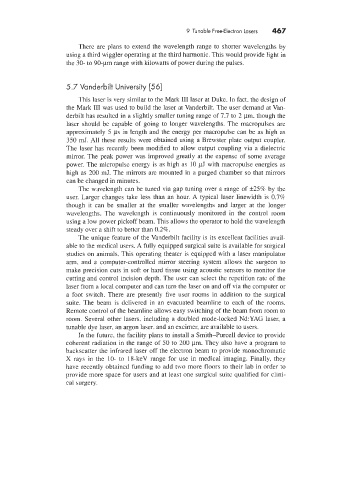Page 507 - Tunable Lasers Handbook
P. 507
9 Tunable Free-Electron Lasers 467
There are plans to extend the wavelength range to shorter wavelengths by
using a third wiggler operating at the third harmonic. This would provide light in
the 30- to 90-pm range with kilowatts of power during the pulses.
5.7 Vanderbitt University [56]
This laser is very similar to the Mark 111 laser at Duke. In fact, the design of
the Mark In was used to build the laser at Vanderbilt. The user demand at Van-
derbilt has resulted in a slightly smaller tuning range of 7.7 to 2 pm, though the
laser should be capable of going to longer wavelengths. The macropulses are
approximately 5 ps in length and the energy per macropulse can be as high as
350 mJ. All these results were obtained using a Brewster plate output coupler.
The laser has recently been modified to allow output coupling via a dielectric
mirror. The peak power was improved greatly at the expense of some average
power. The micropulse energy is as high as 10 pJ with macropulse energies as
high as 200 mJ. The mirrors are mounted in a purged chamber so that mirrors
can be changed in minutes.
The wavelength can be tuned via gap tuning over a range of +258 by the
user. Larger changes take less than an hour. A typical laser linewidth is 0.7%
though it can be smaller at the smaller wavelengths and larger at the longer
wavelengths. The wavelength is continuously monitored in the control room
using a low power pickoff beam. This allows the operator to hold the wavelength
steady over a shift to better than 0.2%.
The unique feature of the Vanderbilt facility is its excellent facilities avail-
able to the medical users. A fully equipped surgical suite is available for surgical
studies on animals. This operating theater is equipped with a laser manipulator
arm, and a computer-controlled mirror steering system allows the surgeon to
make precision cuts in soft or hard tissue using acoustic sensors to monitor the
cutting and control incision depth. The user can select the repetition rate of the
laser from a local computer and can turn the laser on and off via the computer or
a foot switch. There are presently five user rooms in addition to the surgical
suite. The beam is delivered in an evacuated beamline to each of the rooms,
Remote control of the beamline allows easy switching of the beam from room to
room. Several other lasers. including a doubled mode-locked Nd:YAG laser, a
tunable dye laser, an argon laser. and an excimer, are available to users.
In the future, the facility plans to install a Smith-Purcell device to provide
coherent radiation in the range of 50 to 200 pm. They also have a program to
backscatter the infrared laser off the electron beam to provide monochromatic
X rays in the 10- to 18-keV range for use in medical imaging. Finally, they
have recently obtained funding to add tmo more floors to their lab in order to
provide more space for users and at least one surgical suite qualified for clini-
cal surgery.

